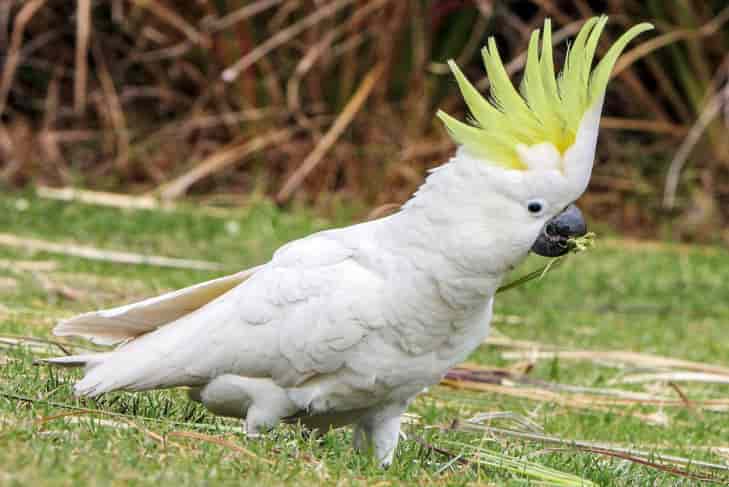Animal behaviour continues to surprise us again and again despite the fact that humankind have spent centuries as their companions! The latest example is that of parrots.
These birds could copy the speech of humans, keep rhythm with music and lend a helping hand to each other. But now a study reveals that they are capable of learning new behaviour from each other. Interestingly this latest find was for long held to be a trait found only in humans.
A common bird in Australia’s Sydney – sulphur-crested cockatoos – which are gregarious and noisy by nature have found out to open the garbage bins. Well, if that is not surprising enough, here’s more as this trait was learnt by others by simply copying the method in order to discover another source of food.
In an article in the National Geographic, according to behavioural ecologist Barbara Klump this discovery suggested that parrots “have joined the club of animals that show culture”. Klump, who works in Max Planck Institute of Animal Behaviour in Germany, leads the study that appears in the journal Science this week.
The culture of forage has been found in other species like crows and great apes. For example, chimpanzees have taught each other new methods to break open a nut.
According to Klump “You would expect parrots also tick all these boxes, but we didn’t have evidence for it”—until now.
The dearth in proof was due to the fact that it is tough to study the cultural behaviour of wild parrots although their counterparts in captivity are well studied. One is not able to account for all the factors that influence the behaviour of the birds in the wild. In the case of cockatoos of Sydney, their frequent use of the same garbage bins proved to be perfect to study them.
Sulphur-crested cockatoos are good looking white parrots with head crests that are vibrant yellow and are two-foot tall. These native of eastern Australia and Pacific Islands, are flourishing especially in urban areas, unlike the other 350 known parrot species.
Those like Timothy Wright, a biologist in New Mexico State University, who have been studying parrots for long are not taken aback by their social learning ability. Though not part of the study team, Wright remarked that the present research will help to further our perception of these birds as very intelligent beings. “I like to call parrots the most human of birds, and this is more evidence in that direction.”
Scientists came to know about the ability of cockatoos to open trash bin somewhere in the mid-2010s. The problem was that this habit was not ubiquitous. “The interesting part was the resource is everywhere, the birds are everywhere, but we didn’t see the behaviour everywhere,” said Klump.
Also read: Rodents too help their near & dear ones just like humans
To find out about this behaviour, Klump and her team conducted an online survey in Sydney and Wollongong areas, enquiring from people if their local cockatoos opened bins. Residents from more than 400 suburbs responded to their online enquiry.
The first survey was done in 2018 in which people residing in three suburbs said they had observed the birds opening their trash cans with claws and beaks. By a year, in 2019, the surveys done, highlighted that this behaviour had spread to 44 suburbs.
The data which was gathered was plotted and a clear pattern emerged – the behaviour was radiating outward – which Klump said suggested that the art of opening the trash bins was learned and not random.
What is interesting is that with the passage of time, the birds developed their own tricks and methods of opening by using their feet or beaks in varied styles. According to the study this is proof of regional subcultures.
Meanwhile, the researchers got the cockatoos to become used to their presence and once this was achieved they smudged nontoxic paint on their feathers, in order to find out which individual bird could open the bins.
Of the 500 marked, it was found that only 10 per cent could achieve this feat. Most were males. This was ascribed to the fact that they were dominant or were bigger and physically more able to pull the lid, said Klump. The ability cut across age as both young and old were found to be adept in it.
Also read: Big eaters, Sea otters have to gorge to keep themselves warm in icy waters
For Australia’s University of Queensland ecologist, Daniella Teixeira, who studies Australian cockatoos, this study, “demonstrates very clearly that cockatoos… can and do shift their feeding behaviours to exploit new resources. And that the behaviour is transmitted and sustained through time—at least over the course of this study.
The study also gives a ray of hope to Teixeira as she wishes that the endangered species of cockatoos also master the novel method to locate food and also share it with their companions. Among the endangered species are Australia’s southeastern red-tailed black cockatoo who are less than 1,500 in the wild.
She was equally impressed by the use of citizens to make this study possible. “It’s cool to see this spread of behaviour in a short amount of time, and even cooler that it’s done through citizen science.”




















